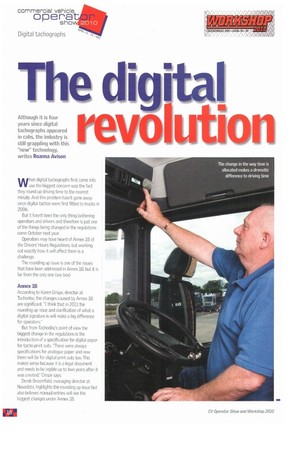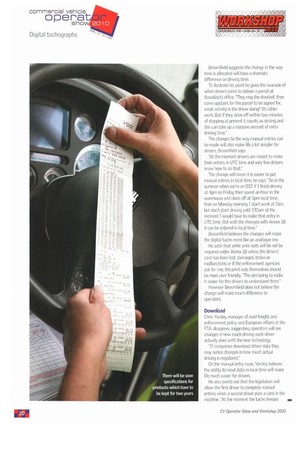A on years since digital tachographs appeared in cabs, the
Page 76

Page 78

Page 80

If you've noticed an error in this article please click here to report it so we can fix it.
industry is When digital tachographs first came into use the biggest concern was the fact they round up driving time to the nearest minute. Arid this problem hasn't gone away since digital tachos were first fitted to trucks in 2006.
But it hasn't been the only thing bothering operators and drivers and therefore is just one of the things being changed in the regulations come October next year.
Operators may have heard of Annex 1B of the Drivers' Hours Regulations, but working out exactly how it will affect them is a challenge.
The rounding up issue is one of the issues that have been addressed in Annex 1B, but it is far from the only one (see box)
Annex 1B
According to Karen Crispe, director at Tachodisc, the changes caused by Annex 1B are significant "1 think that in 2011 the rounding up issue and clarification of what a digital signature is will make a big difference for operators."
But from Tachodisc's point of view the ' biggest change in the regulations is the introduction of a specification for digital paper for tacho print outs. "There were always specifications for analogue paper and now there will be for digital print outs too. This makes sense because it is a legal document and needs to be legible up to two years after it was created," Crispe says.
Derek Broomfield, managing director at Novadata, highlights the rounding up issue but also believes manual entries will see the biggest changes under Annex la
Broomfield suggests the change in the way time is allocated will have a dramatic difference on driving time.
To illustrate his point he gives the example of when drivers come to deliver a parcel at Novadata's office. "They ring the doorbell, then come upstairs for the parcel to be signed for, what activity is the driver doing? It's other work. But if they drive off within two minutes of stopping at present it counts as driving and this can take up a massive amount of extra driving time."
The changes to the way manual entries can be made will also make life a lot simpler for drivers, Broomfield says.
"At the moment drivers are meant to make their entries in UTC time and very few drivers know how to do that" The change will mean it is easier to put manual entries in local time, he says. "So in the summer when we're on BST if I finish driving at 4pm on Friday, then spend an hour in the warehouse and clock off at 5pm local time, then on Monday morning I start work at 7am, but don't start driving until 730am at the moment I would have to make that entry in UTC time. But with the changes with Annex 1B it can be entered in local time."
Broomfield believes the changes will make the digital tacho more like an analogue one.
He adds that while print outs will be not be required under Annex 1B unless the drivers' card has been lost, damaged, stolen or malfunctions or if the enforcement agencies ask for one, the print outs themselves should be more user friendly. "The aim being to make it easier for the drivers to understand them."
However Broomfield does not believe the change will make much difference to operators.
Download Chris Yarsley, manager of road freight and enforcement policy and European affairs at the FTA, disagrees, suggesting operators will see changes in how much driving each driver actually does with the new technology.
"If companies download driver data they may notice changes in how much actual driving is registered."
On the manual entry issue, Yarsley believes the ability to input data in local time will make life much easier for drivers.
He also points out that the legislation will allow the first driver to complete manual entries when a second driver puts a card in the
machine. "At the moment the tacho freezes mo
when the second card is put in and prevents those manual entries.
"It should also give more time for drivers to make their manual entries," Yarsley says. "At present when you insert a drivers card it gives drivers up to a minute to make manual entries, now if operators ask for it to be calibrated to allow the extra time, drivers could have up to 20 minutes to make those manual entries."
While predicting Annex 1B will make a big difference to the functionality and usability of digital tachographs, Peter Needham, product manager for VDO at Continental Automotive, believe there is a lot that will happen before October 2011. "The main area that will have an impact in the next 12 months is remote downloading of data," Needham says.
"At the moment the regulations allow telematics companies to download certain data that's not new but now that data can be downloaded with a digital signature which is a way of ensuring the integrity of that data. It proves authenticity of the data.
"What is new is remotely downloading data and having a digital signature attached as well."
Tachos with this functionality went on sale in new trucks at the beginning of last year, but because of the recession companies are only now beginning to buy new vehicles.
Different depots
Needham believes this functionality will be useful for operators that have vehicles at different depots across the country or trucks that are abroad for long periods of time.
There are two types of system wide range and short range. Wide range uses a mobile wireless network via GPRS. Data is downloaded onto a server which the operator can then access. They no longer have to go out to the vehicle with the company card to download the data. The short range device uses a wireless LAN, so there are no network costs, but it will only work when the vehicle is in the yard.
For conventional downloads this type of tacho provides a quicker download speed which is something operators have asked for.
Needham adds graphical print outs are available with these new tachos. "They provide graphical information relating to driver mode activity for seven days, such as weekly rest, daily rest, breaks arid driving time. It also records 168 hours of speed information, while previous generation have only held the 24 hours worth of information required by the regulations."
It seems the industry will have a lot of change to contend with in the coming years, but hopefully the changes will make life easier for driver and operator alike. •






























































































































































































